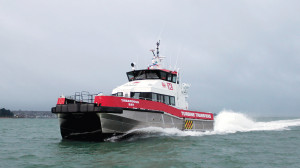The New Standard in Propulsion Efficiency and On-Board Comfort
 At the end of 2014 the first vessel driven by the new Voith Linear Jet (VLJ) propulsion system was successfully tested outside the Isle of Wight in Southern England. The innovative propulsion system has performed convincingly all along the line and by far surpassed the expectations of her owner, the Welsh company Turbine Transfers, a subsidiary of well-known workboat operators Holyhead Towing Company.
At the end of 2014 the first vessel driven by the new Voith Linear Jet (VLJ) propulsion system was successfully tested outside the Isle of Wight in Southern England. The innovative propulsion system has performed convincingly all along the line and by far surpassed the expectations of her owner, the Welsh company Turbine Transfers, a subsidiary of well-known workboat operators Holyhead Towing Company.
The VLJs are the main propulsion system of the modern DNV Classed 21m offshore service catamaran, which was designed for Turbine Transfers by BMT Nigel Gee and built by AMC. The Crew Transport Vessel will take service technicians to offshore wind farms at sites all around Europe, initially at the Westernmost Rough site off the Humber for Dong Energy. The CTV has achieved a trials speed of 30 knots, above expectations, compared to 26.5 knots for a near sister with jet propulsion. Even if the current installed ten cylinder 900kW Diesels would be replaced for eight cylinder 720kW Diesels the economical service speed of 25 knots required by Turbine Transfers would still be met.
The experts at Turbine Transfers are delighted with the novel Voith drive system. “The vessel is achieving more thrust at high speeds, and when stopped in the water and pushing on a Turbine than with conventional systems, while achieving significantly lower noise and vibration levels,” stated Alistair Knowles, Marine Superintendent at Turbine Transfers. “Furthermore it improves our green credentials through substantial fuel and emission savings in our operations.”
The Voith Linear Jet is a new propulsor combining the best properties of conventional propellers with the best properties of conventional waterjets. This combination makes the low maintenance propulsor the ideal solution for ships with mixed operating profiles up to 40 knots.
The Voith engineers designed and developed the VLJ exclusively by computer, applying the CFD (Computational Fluid Dynamics) method. With a tradition of almost 150 years of hydro power development, Voith was one of the first adopters of the CFD technology. Today CFD is still becoming more and more powerful; making it possible to master even highly complex interaction effects.






